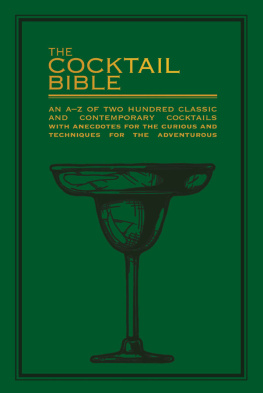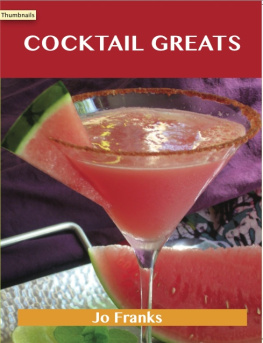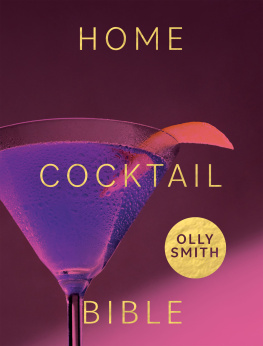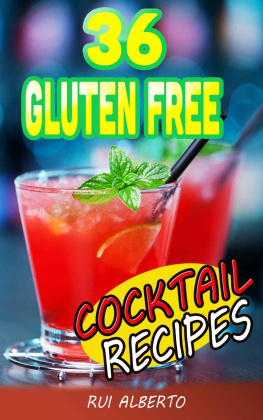

CONTENTS
HOW TO USE THIS EBOOK
Select one of the chapters from the and you will be taken to a list of all the recipes covered in that chapter. Alternatively, jump to the to browse recipes by ingredient. Look out for linked text (which is in blue) throughout the ebook that you can select to help you navigate between related recipes. You can double tap images to increase their size. To return to the original view, just tap the cross in the top left-hand corner of the screen.
INTRODUCTION
As with any cultural curiosity that drifts in and out of fashion, it feels right now that we have discovered something completely new.
But cocktails and mixed drinks have always been here. From punches to Sours, Martinis to Spritzes, their origins date back centuries. They were derived from simple shared concepts, and then built upon by proceeding generations as time passed, demand evolved and tastes shifted. Aside from being adventurous, delicious, evocative, fun and sociable, they are fascinating. The things that go into them and the reasons they came to be are of genuine interest to anybody. Each individual drink, each spirit or liqueur, each piece of glassware, contains a history lesson in itself.
Drinks are symbols. Though they are made of liquid, and drunk from a vessel of one form or another, they are not just a collection of materials. They have meaning, they carry stories and they mark time. That time might have been a solely specific moment, or a particular drink might be more loosely reflective of the point in history that it was created. Or they can be present-day celebrations, occasions. A wedding, an anniversary, a promotion, a beginning or an ending.
Maybe its just the end of the day in a bar with somebody you love. But they are not only markers of time. They are expressions of hard work, clarity of vision and refinement of process. They contain ideas, they were created by people, are made by people and (unless like me youre from the south west of England where even the ducks drink cider) they are consumed by people. The making of things in this case a simple mixed drink can actually have broader personal applications. By assembling a cocktail at home with care, attention and no little affection, we can connect simply and directly with that most magical and elusive of human endeavours personal process.
That engagement with process, like any craft-based activity, can provide us with a satisfaction that will only permeate positively into other areas of our lives. But what are cocktails? A stimulating liquor, composed of spirits of any kind, sugar, water and bitters said the American writer Harry Croswell in 1806. Wholly true, and taken loosely, that description is the basis of all mixed drinks. But the idea of the cocktail is a wildly appropriated notion to start with. Bartenders or (yawn) mixologists were the original fusion chefs. It is rare in cookery that you would put barley from Scotland, grapes from Italy and cloves from Trinidad and Tobago on the same plate in fact youd most likely be moved to the silly section of the kitchen if you did.
But barley makes whisky, grapes make sweet vermouth, Angostura bitters are made from cloves, and their sum parts were judiciously combined at the Waldorf Astoria in New York City in 1894 to create the Rob Roy cocktail, a drink exemplifying the very virtues of balance and nuanced harmony. With cocktails, the rules are a bit different. That being said, locality will always factor, as historically what was grown, produced or imported nearest-by would most probably have ended up in the drink. When it comes to how we do it, whether we are creating something completely new or re-interpreting an age-old standard, we always strive for balance. Complementary combinations, layered with complexity and balanced with simplicity. The basis of classical cocktail-making lies in the balance between sweet and sour.
That balance is expressed most commonly through citrus juice and sugar, the building blocks of a drink upon which nearly all the classics sit. So, after a while you will notice recurring themes. A spirit, a citrus element and a sweet element. After that, those base components could be augmented with a modifier; the sweet element might become a liqueur, or the citrus might become a softer fruit juice used to lengthen a drink while retaining sharpness. Teas or wines could be added to give background complexity. On and on it goes.
May it never end. The thing to remember is this. The development and delivery of food and drink reside in an endlessly contradictory halfway house of strictly measured and repeated precision, and the unmeasurable sense of the felt. The recipe may be the recipe, and it may be a hundred years old, but if you feel on a wet Wednesday that you need a dash more lime juice in your Daiquiri, then that really is your decision, and that feeling should be responded to, and that is how it should always be. If you don't state a clear preference, then your drink is like a bad game of poker or a hasty drug transaction: It is whatever the dealer says it is. Please do try to bear this in mind.Christopher Hitchens, Everyday Drinking
TECHNIQUE AND METHOD
A guide to the equipment and techniques that are used, not only in this book, but in bars of note all over the world.
Even the simplest drinks require a preparation of sorts, but cocktails can present some potentially intimidating challenges. There are pieces of kit, there are tools, there are measurements, there are dry ingredients and liquid ingredients; there is the weight of hundreds of years of history and, to cap it all off, there is Tom Cruise throwing bottles around behind bars in films to contend with too. But in truth its really quite simple. Making a cocktail is just like anything else where a process needs to be engaged with or instructions need to be followed; it is as difficult as you make it. Do remember to have fun. 
SHAKING
Shaking is the most universally recognizable way of preparing a drink.
We shake a cocktail for four reasons: to mix it, to chill it, to dilute it and to create texture through aeration. Generally speaking there are two types of cocktail shaker commonly used: the three-part shaker (or COBBLER SHAKER ) and the two-part shaker (or BOSTON SHAKER ). For our purposes, the method will always be the same. Always use good-quality, completely frozen cubes of ice, never cracked or crushed. IF USING A THREE-PART SHAKER: Add your ingredients to the bottom piece and two-thirds fill with ice, affix the other two pieces and shake vigorously for 510 seconds.  IF USING A TWO-PART SHAKER: Add the ingredients to the glass or smaller part of your shaker, and then two-thirds fill the larger part with ice.
IF USING A TWO-PART SHAKER: Add the ingredients to the glass or smaller part of your shaker, and then two-thirds fill the larger part with ice.
Bring the two parts together, clasp firmly with both hands and shake vigorously for 510 seconds.
Next page









 IF USING A TWO-PART SHAKER: Add the ingredients to the glass or smaller part of your shaker, and then two-thirds fill the larger part with ice.
IF USING A TWO-PART SHAKER: Add the ingredients to the glass or smaller part of your shaker, and then two-thirds fill the larger part with ice.